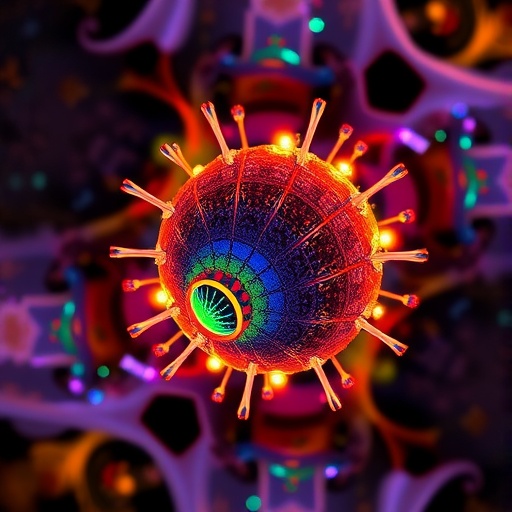In a pioneering advance that promises to transform the landscape of optical imaging, researchers have unveiled a groundbreaking technique for three-dimensional nanoscopy that achieves an unprecedented axial resolution of approximately λ/33. This remarkable feat, detailed in a recent publication in Light: Science & Applications, not only shatters prior limitations in axial resolution but also introduces a sidelobe-free deterministic approach that dramatically enhances image clarity and fidelity in 3D nanoscale imaging.
The axial resolution of optical systems traditionally faces a formidable barrier imposed by the diffraction limit, which restricts the ability to distinguish features separated by less than roughly half the wavelength of the light used. While lateral resolution improvements have seen significant progress through techniques like stimulated emission depletion (STED) microscopy and structured illumination microscopy, axial resolution has remained comparatively stagnant. The breakthrough achieved by Pan, Wang, Ni, and colleagues pushes beyond these constraints by more than an order of magnitude, effectively enabling visualization deeper into volumetric samples with a clarity previously thought unattainable.
Central to this innovation is the concept of sidelobe suppression in the point spread function (PSF), a crucial factor that determines image quality in optical microscopy. Sidelobes manifest as unwanted secondary peaks in the PSF, contributing to image artifacts and reducing contrast. The newly introduced deterministic technique eliminates these sidelobes, thus creating a near-ideal PSF profile that facilitates clearer and more accurate axial sectioning. This refinement ensures that the reconstructed images accurately represent the sample’s true three-dimensional structure without spurious interference.
The methodology incorporates a sophisticated design of excitation patterns and detection schemes orchestrated in a deterministic manner, contrasting with traditional stochastic approaches that rely on probabilistic photon emissions. By deterministically modulating the illumination and detection pathways, the researchers achieve precise spatial confinement of the excited volume, thereby sharply enhancing the axial resolving power. This control is accomplished through an intricate interplay of optical phase modulation and tailored beam shaping, harnessing the wave nature of light to surpass conventional imaging limits.
Importantly, the technique leverages advances in photonic hardware and computational algorithms. Custom-designed optical elements facilitate the generation of complex light fields with tailored phase and amplitude distributions. Simultaneously, cutting-edge signal processing algorithms reconstruct the high-resolution three-dimensional images from the detected signals, compensating for residual aberrations and optimizing image quality. This synergy of optics and computation epitomizes the trend toward computational imaging paradigms in modern microscopy.
Experimental validation of this approach showcased its ability to resolve nanostructures with axial separations on the order of a few nanometers, a scale where quantum mechanical and electromagnetic interactions become increasingly significant. The researchers demonstrated the capacity to visualize intricate biological structures and engineered nanomaterials with unprecedented precision, enabling new insights into cellular architecture and nanoscale fabrication processes.
Moreover, the elimination of sidelobes not only enhances resolution but also improves quantitative accuracy in volumetric measurements. In applications such as protein localization within cells, understanding subcellular dynamics, and characterizing nanoscale devices, accurate axial information is vital. The sidelobe-free deterministic 3D nanoscopy addresses these needs by reducing cross-talk and signal contamination between closely spaced features, thus bolstering the reliability of data interpretation.
Another noteworthy aspect is the adaptability of the technique to various imaging modalities and sample types. The deterministic excitation framework is not limited to a single wavelength or fluorophore but can be generalized across diverse fluorescent markers and scattering media. This flexibility positions the approach as a universally applicable tool that can be integrated into existing microscopy platforms with minimal modifications.
The implications of attaining a λ/33 axial resolution extend beyond fundamental research. In semiconductor manufacturing, for instance, there is an ever-growing demand for metrology tools capable of characterizing three-dimensional nanostructures with utmost precision to ensure device performance and yield. The sidelobe-free deterministic 3D nanoscopy offers a non-invasive, high-throughput solution suited for real-time inspection and quality control, potentially revolutionizing industrial standards.
Furthermore, the biomedical research community stands to benefit tremendously from this advancement. The ability to dissect complex tissue architectures and monitor dynamic biological processes at nanometer scales and in three dimensions holds promise for breakthroughs in neurobiology, cancer research, and developmental biology. Such detailed visualization may uncover previously hidden mechanisms underlying health and disease.
The researchers also emphasize the deterministic nature of their approach as a paradigm shift from conventional stochastic super-resolution methods. Deterministic methods offer reproducibility, robustness, and predictability, characteristics that are essential for clinical translation and regulatory approval in diagnostic applications. The sidelobe-free property contributes directly to these attributes by minimizing artifacts and enhancing signal-to-noise ratios.
Looking forward, the integration of this technology with complementary imaging techniques such as multiphoton microscopy, adaptive optics, and label-free imaging could further extend its reach. Combining ultra-high axial resolution with deep tissue penetration and minimal phototoxicity would enable unprecedented explorations in living systems and complex environments.
In summary, the work by Pan et al. represents a striking leap forward in optical nanoscopy, delivering both theoretical and practical innovations that redefine three-dimensional imaging capabilities. Achieving sidelobe-free deterministic 3D nanoscopy with an axial resolution down to λ/33 challenges entrenched optical limits and opens vast new avenues for research and application spanning physics, materials science, biology, and engineering.
As optical microscopy continues to evolve, such transformative techniques herald a future where nanoscale visualization is not an obstacle but a routine reality, empowering scientists and engineers to interrogate the microscopic world with clarity and confidence never before possible.
Subject of Research:
3D nanoscopy and optical imaging techniques with resolution beyond the diffraction limit.
Article Title:
Sidelobe-free deterministic 3D nanoscopy with λ/33 axial resolution.
Article References:
Pan, B., Wang, B., Ni, Y. et al. Sidelobe-free deterministic 3D nanoscopy with λ/33 axial resolution. Light Sci Appl 14, 168 (2025). https://doi.org/10.1038/s41377-025-01833-x
Image Credits: AI Generated
DOI: https://doi.org/10.1038/s41377-025-01833-x
Tags: 3D nanoscale imaging techniquesadvancements in optical imaging technologydeterministic imaging approachesenhanced image clarity in nanoscopyinnovative imaging solutions for researchLight: Science & Applications publicationnanoscopy advancements in scientific researchoptical systems resolution improvementsovercoming diffraction limits in microscopysidelobe suppression in optical microscopyvolumetric sample visualization methodsλ/33 axial resolution breakthrough





